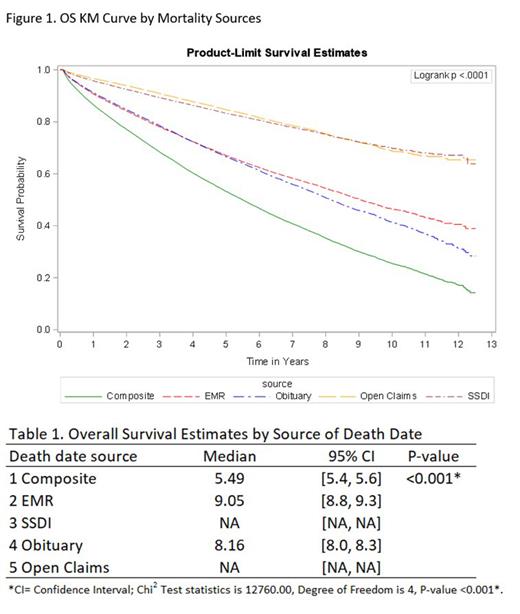Introduction: Utilization of real-world data (RWD) has progressively grown as a valuable supplement to randomized clinical trials in the context of drug development. Overall survival (OS) is a critical measure for assessing treatment effectiveness. Nevertheless, due to the frequent incompleteness in mortality data in the real world, there is a potential for overestimating OS. RWD has facilitated substantial research on multiple myeloma (MM), the second most prevalent hematologic malignancy. Given the paramount importance of OS as a clinical outcome in hematology and oncology settings, ensuring the completeness of mortality data is of utmost significance. The purpose of this study was to assess how different types of RWD mortality data sources affect OS estimates among patients with MM.
Methods: This retrospective study included patients aged ≥18 years with initial diagnosis of MM between January 1, 2011, and December 31, 2022. Excluded populations consisted of those with an initial diagnosis of one or more primary malignancies other than MM, non-melanoma skin cancer, and/or cervical carcinoma in situ, and follow-up time <30 days. The study population was derived from ConcertAI real-world electronic medical record (EMR)-based oncology data (ConcertAI RWD360 dataset), representing approximately 7.6 million cancer patients from community and academic oncology practices throughout the United States. Death information is available as captured in the EMR as well as through patient-level linkage from external sources including the Social Security Death Index (SSDI), obituary, and open claims. Patients were categorized based on their source of death date. One composite death date based on the hierarchical order of availability from EMR, SSDI, obituary, and open claims was generated. OS was defined from the time of initial diagnosis date of MM to date of death. Patients were censored at the last recorded clinical activity date. Kaplan-Meier (KM) methods and Log-Rank tests were used to estimate OS across different mortality source categories.
Results: The study population included 49,541 patients (53.1% male, 61.0% white) with a median age of 68 years (range: 18, 88) at initial MM diagnosis. Median follow-up from diagnosis to death or censored date was 2.4 years (range: 0.1, 12.5). Distribution of deceased patients by year of diagnosis was similar between the four sources. The number and percentage of patients with death event and date in each source were: 12,599 (25.4%) from obituary, 11,734 (23.7%) from EMR, 5,453 (11.0%) from SSDI, and 4,972 (10.0%) from open claims. Upon hierarchical integration of death date from the individual sources, 19,909 (40.2%) patients had an event. Figure 1 and Table 1 present the KM OS results by the death sources.
Conclusion: This study evaluated the completeness of death date from multiple sources and its impact on OS estimates for an EMR-selected MM patient population. Among the sources evaluated, EMR and obituary had the highest level of death information captured relative to SSDI and open claims. Highest completion of death date was achieved when EMR death date was integrated with external data from obituary, SSDI, and open claims, resulting in OS estimates that are consistent with previous knowledge on MM prognosis. Completeness in capture of mortality data is essential to generate reliable estimates of OS in real-world studies, and integration of death information from multiple sources is critical in achieving this augmentation.
Disclosures
Liu:AbbVie: Research Funding; Astellas: Research Funding; Amgen: Research Funding; AstraZeneca: Research Funding; Bristol Myers Squibb: Research Funding; Boehringer Ingelheim: Research Funding; Daiichi Sankyo: Research Funding; GlaxoSmithKline: Research Funding; Incyte: Research Funding; Janssen: Research Funding; Kyowa Kirin: Research Funding; Merck: Research Funding; Novartis: Research Funding; Novartis: Research Funding; Regeneron: Research Funding; Sandoz: Research Funding; Teva: Research Funding. Lan:AbbVie: Research Funding; Amgen: Research Funding; Novartis: Research Funding; Boehringer Ingelheim: Research Funding; Astellas: Research Funding; AstraZeneca: Research Funding; Bristol Myers Squibb: Research Funding; Merck: Research Funding; Daiichi Sankyo: Research Funding; Regeneron: Research Funding; Incyte: Research Funding; Gilead: Research Funding; Janssen: Research Funding; Kyowa Kirin: Research Funding; GlaxoSmithKline: Research Funding; Sandoz: Research Funding; Teva: Research Funding. Walker:Teva: Research Funding; Sandoz: Research Funding; GlaxoSmithKline: Research Funding; Boehringer Ingelheim: Research Funding; Kyowa Kirin: Research Funding; Janssen: Research Funding; Daiichi Sankyo: Research Funding; Astellas: Research Funding; AbbVie: Research Funding; AstraZeneca: Research Funding; Regeneron: Research Funding; Novartis: Research Funding; Merck: Research Funding; Incyte: Research Funding; Bristol Myers Squibb: Research Funding; Gilead: Research Funding; Amgen: Research Funding. Ray:Amgen: Research Funding; Bristol Myers Squibb: Research Funding; Gilead: Research Funding; Incyte: Research Funding; Merck: Research Funding; Novartis: Research Funding; Regeneron: Research Funding; AstraZeneca: Research Funding; AbbVie: Research Funding; Astellas: Research Funding; Daiichi Sankyo: Research Funding; Janssen: Research Funding; Kyowa Kirin: Research Funding; Boehringer Ingelheim: Research Funding; GlaxoSmithKline: Research Funding; Sandoz: Research Funding; Teva: Research Funding. Smith:Amgen: Research Funding; Bristol Myers Squibb: Research Funding; Gilead: Research Funding; Incyte: Research Funding; Merck: Research Funding; Novartis: Research Funding; AstraZeneca: Research Funding; AbbVie: Research Funding; Astellas: Research Funding; Daiichi Sankyo: Research Funding; Janssen: Research Funding; Kyowa Kirin: Research Funding; Boehringer Ingelheim: Research Funding; GlaxoSmithKline: Research Funding; Sandoz: Research Funding; Teva: Research Funding.


